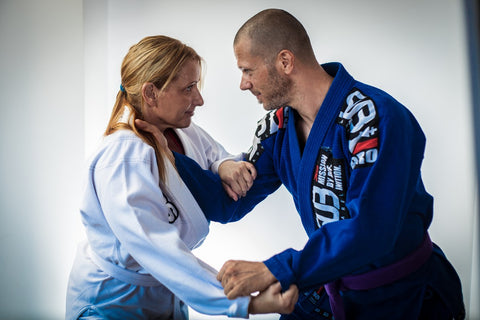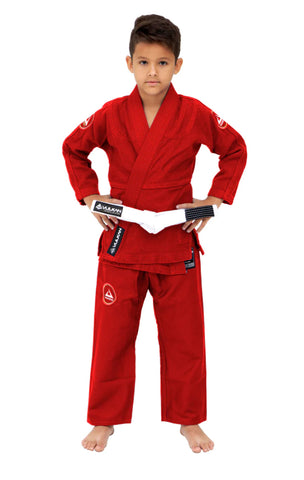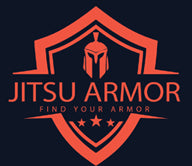
Brazilian Jiu-Jitsu (BJJ) is a martial art that focuses on ground-based combat, intricate techniques, and the art of submission. While the sport is often practiced in a controlled environment with strict rules and regulations, it's not without its share of physical demands and risks. This is where Jiu-Jitsu armor comes into play. In this blog post, we'll explore the benefits of wearing Jiu-Jitsu armor, how it can improve your training, and its crucial role in ensuring safety on the mats.
The Essence of Jiu-Jitsu Armor
Jiu-Jitsu armor, often referred to as a gi (pronounced "gee"), is the traditional uniform worn by BJJ practitioners. It consists of a jacket (or top), pants, and a belt. This clothing may seem simple at first glance, but it serves several vital functions in the world of BJJ. It's not just attire; it's a form of armor designed to provide both practical and safety benefits.
Durability:
Jiu-Jitsu gis are constructed from sturdy materials, such as cotton, hemp, or specialized weaves. These fabrics are designed to withstand the rigors of training and sparring. The reinforcement at stress points, such as the knees, armpits, and lapels, ensures the gi's longevity.
Grip and Control:
The texture and design of the gi provide grip and control during BJJ techniques. Gripping your opponent's gi is an integral part of the sport. It allows you to manipulate your opponent's movements, control their posture, and execute various techniques like chokes and joint locks. The gi's lapels, sleeves, and pant legs become valuable tools for a BJJ practitioner.
Hygiene:
The gi helps maintain a level of hygiene on the mats. It acts as a barrier between your body and your training partner's skin, reducing direct skin-to-skin contact. This is especially important in a sport where practitioners often sweat profusely and come into close contact with one another.
Tradition and Identity:
The gi also plays a significant role in preserving the tradition and identity of Brazilian Jiu-Jitsu. It's a symbol of respect for the martial art's history and lineage, and it distinguishes BJJ from other grappling sports.
Now that we've established the core functions of the Jiu-Jitsu armor, let's delve into how wearing it can enhance your training and ensure safety.

Improving Your Training with Jiu-Jitsu Armor
Enhanced Grip and Control:
Wearing a gi provides an additional dimension to your training. The fabric of the gi can be gripped and controlled, allowing you to manipulate your opponent effectively. You can use the gi's lapels, sleeves, and pants to secure dominant positions, set up submissions, and control your opponent's posture. This added layer of complexity in training promotes a deeper understanding of leverage and technique.
Versatility in Techniques:
The gi opens up a wide array of techniques that are not easily applied in no-gi (without a gi) situations. Collar chokes, gi-based guard passes, and lapel sweeps are just a few examples. By training with the gi, you expand your technical repertoire, making you a more versatile and well-rounded BJJ practitioner.
Transferable Skills:
Training with the gi can enhance your skills in no-gi grappling as well. The grips and controls you learn while wearing the gi translate well to no-gi situations. The added sensitivity to grips and leverage can be a valuable asset in your overall grappling game.
Better Adaptation:
BJJ practitioners often encounter different scenarios, and it's crucial to adapt to varying conditions. Training with the gi prepares you for the gi-specific situations you might encounter in competition. Whether you compete in the gi or not, the experience and adaptability gained from training with the gi are invaluable.
Improved Timing and Precision:
Grappling with a gi demands precise timing and control. By practicing with the added resistance and friction of the gi, you develop a heightened sense of timing and the ability to execute techniques with greater precision. This focus on timing and precision can elevate your overall BJJ game.
Increased Resilience:
Wearing a gi can make training more challenging due to the additional friction and resistance it provides. This extra difficulty can lead to increased resilience and physical conditioning. Training in a gi can be physically demanding, contributing to improved stamina and endurance.

Safety Benefits of Wearing Jiu-Jitsu Armor
While the training benefits of wearing Jiu-Jitsu armor are clear, the safety benefits are equally, if not more, significant. BJJ can be a physically demanding and intense sport, and the gi plays a pivotal role in ensuring safety on the mats.
Joint Protection:
The gi provides an extra layer of protection for your joints. When your opponent attempts joint locks or submissions, the gi can offer a cushioning effect, reducing the risk of injury. This added layer of protection is particularly important for beginners who are still learning to tap out effectively.
Slower Pace:
Training in the gi tends to be at a slower pace than no-gi training. The added grips and controls create a more methodical and measured approach to rolling. This slower pace can be beneficial for both beginners and experienced practitioners, as it reduces the likelihood of reckless movements and accidents.
Reduced Friction Burns:
During no-gi grappling, friction burns are not uncommon, as the skin comes into direct contact with your training partner's body. In contrast, the gi acts as a protective barrier, reducing the risk of friction burns, abrasions, and mat burns.
Controlled Movement:
The gi's grip and control system allow for a degree of control over your opponent's movements. This control can prevent sudden, jerky movements that could lead to accidental injury. It also allows you to dictate the pace and intensity of your rolls, contributing to a safer training environment.
Improved Communication:
Wearing a gi facilitates communication between training partners. Grips, pressure, and positional cues are often conveyed through the gi. This communication helps prevent misunderstandings and accidental injuries during training.
Tapping Awareness:
In BJJ, tapping (physically or verbally signaling submission) is a fundamental safety practice. Wearing a gi makes it easier for both you and your training partner to feel and recognize taps, ensuring that submissions are released promptly to prevent injury.
Conclusion: The Vital Role of Jiu-Jitsu Armor
In the world of Brazilian Jiu-Jitsu, the gi is more than just clothing; it's a form of armor that enhances training and ensures safety on the mats. The benefits of wearing Jiu-Jitsu armor are vast, from improved grip and control to expanded technical proficiency. It's a versatile tool that allows practitioners to develop a deeper understanding of the art while promoting safety and injury prevention.
Whether you're a beginner looking to start your BJJ journey or an experienced practitioner seeking to refine your skills, the gi is an essential part of the equation. Its unique attributes make it an indispensable component of the BJJ experience, and embracing the gi is not just a matter of tradition but also of wisdom on your journey.


